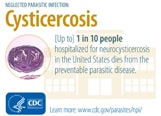Parasites - Cysticercosis

Cysticercosis is a parasitic tissue infection caused by larval cysts of the tapeworm Taenia solium. These larval cysts infect brain, muscle, or other tissue, and are a major cause of adult onset seizures in most low-income countries. A person gets cysticercosis by swallowing eggs found in the feces of a person who has an intestinal tapeworm. People living in the same household with someone who has a tapeworm have a much higher risk of getting cysticercosis than people who don’t. People do not get cysticercosis by eating undercooked pork. Eating undercooked pork can result in intestinal tapeworm if the pork contains larval cysts. Pigs become infected by eating tapeworm eggs in the feces of a human infected with a tapeworm.
Both the tapeworm infection, also known as taeniasis, and cysticercosis occur globally. The highest rates of infection are found in areas of Latin America, Asia, and Africa that have poor sanitation and free-ranging pigs that have access to human feces. Although uncommon, cysticercosis can occur in people who have never traveled outside of the United States. For example, a person infected with a tapeworm who does not wash his or her hands might accidentally contaminate food with tapeworm eggs while preparing it for others.
Images: Left: Taenia egg at a high magnification of 400x. When consumed by humans, Taenia solium eggs can lead to cysticercosis, including a serious condition known as neurocysticercosis. Center: A radiographic image of the brain of a patient who has neurocysticercosis; the small dark spots within the brain are larval cysts of T. solium. Right: A cross-section through a T. solium cyst from a human brain tissue specimen, stained with hematoxylin and eosin (H&E). (Credit: Westchester Medical Center, PHIL, DPDx)
